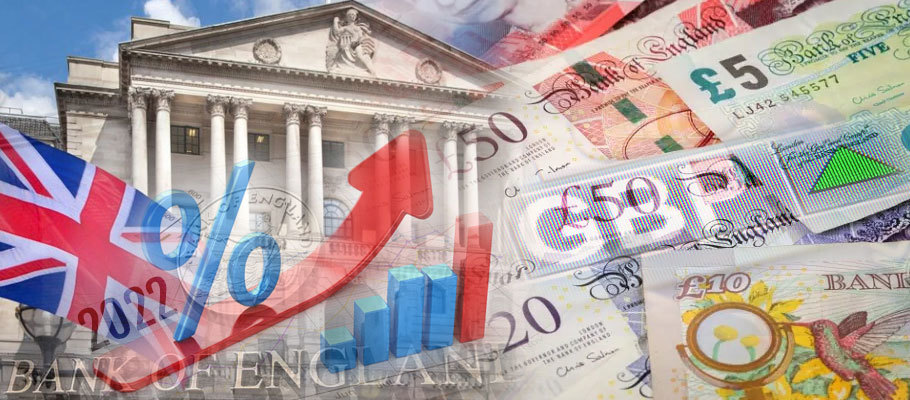
Published: August 27th, 2021
The Bank of England (BoE) is ready to hike interest rates in the third quarter of 2022 if the reaction of forex and interest rate markets to this week’s August policy update is any guide.
Sterling experienced some volatility around the Wednesday announcement but settled back into the range seen in recent days, reinforcing the notion that markets are factoring in a rate rise in the first half of next year.
According to analysts, significant gains or dips in the pound’s value would have suggested a bigger shift in market expectations in response to the bank's guidance and forecasts.
According to a statement issued this week from Threadneedle Street, the BoE Monetary Policy Committee (MPC) believes that the current global and domestic inflation spike will be temporary, so there’s no need to rush into an early rate rise.
Britain’s economy, however, is forecast to experience a lengthier period of above-target inflation than was predicted in the committee’s May report. That suggests sitting on record-low inflation levels can’t be sustained over the medium term.
Inflationary pressures are still predicted to ease, with CPI inflation expected to return to closer to the two per cent objective; this is according to the bank's quarterly Monetary Policy Report.
BoE policymakers think the medium-term inflation driving current policy decisions is creating a delay between decisions made today and their effect on the broader economy.
The bank’s belief that inflation will still be at +/- two per cent in three years suggests the post-financial crisis period of under-target inflation rates is over, an assessment that hints at a new era of higher interest rates.
At ING Bank's Developed Markets Economics Unit, Analysts told Reuters that the bank’s forecasts are being driven by market pricing.
‘That suggests policymakers are more or less relaxed about the limited tightening investors are factoring in over the next couple of years. The idea that higher inflation is temporary has been tested and found wanting. With the 24-months above target timeline now indicated by the monetary policy committee, we think it’s safe to call that a pretty sustained period.’
The Bank's Monetary Policy Report said economists were now forecasting the UK economy to rise back up to pre-crisis out levels by Q4 of this year.
The pound-to-euro (GBP/EUR) rate traded in range at 1.1745 in the immediate aftermath of the announcement. The pound-to-dollar (GBP/USD) rate hovered around 1.3922, meaning neither bulls nor bears could make definitive moves.
This week the BoE also set out its updated strategy to begin scaling down economic stimulus. It plans to start reducing the volume of asset purchases in its quantitative easing programme (QE), first by not reinvesting any maturing assets. The trigger for that stance will be when the bank rate rises back to 0.5 per cent. The target was previously set at 1.5 per cent.
‘The pace of unwinding may be a bit faster than we expected, assuming the bank ceases all reinvestments immediately on the target being hit and starts selling bonds back into the market,’ said a morning analysis by JP Morgan in London.
‘If the Bank of England announces that they will stop reinvesting before rate hikes, this will likely be interpreted as a dovish indication that the first rate hike will be pushed back.
However, Morgan analysts also noted that the bank has effectively endorsed market expectations for the interest rates outlook for the first time since the pandemic began.
They point to a line in the BoE’s August statement that wasn’t added to the May statement:
‘Updated activity and inflation forecasts published in the August Monetary Policy Report assume that the impact of Covid on the UK economy will diminish as time passes. Those expectations are conditioned, however, on the market path for interest rates.’
In other words, bank policymakers are signalling that inflation will rise above the two per cent horizon despite an expected rise in interest rates next year.
Bank Governor Andrew Bailey told journalists at the May Monetary Policy Report press conference that it’s not the bank’s role to validate market expectations. But the extra line of guidance suggests the bank was keen to keep pace with the market's expectations for a rate rise.
Analysts at Barclay’s Currency Markets said in a note to investors that ‘traders should look for the first interest rate rise in the second half of 2022, with investors currently pricing in expectations for June. That said, if the economy continues its upward growth with inflation above the two per cent target, it might provide the BoE with justification to act faster.’
Some economists remain unconvinced that a 2022 interest rate hike is in the offing.
Rod Gallifry, Senior Economist at Capital Markets, told Bloomberg that despite the signals that higher interest rates could be on the horizon, ‘it’s more plausible to expect that the MPC will continue to be cautious, potentially sitting on rates until 2023 before tightening policy.
He says the MPC’s policy statement was more hawkish than Capital Markets had expected. The firm is forecasting inflation to be below the BoE’s expectations, ‘which supports our belief that policy won’t be tightened for another 18 months at least.’
Back at ING, analysts are also looking for a rates lift-off in 2023 rather than 2022, saying upcoming economic statistics will cool the bank's rising expectations.
ING is looking for UK economic growth of 1.4 per cent in Q3, less than half the three per cent forecast by Threadneedle Street.
If the naysayers turn out to be correct, then it follows that pound exchange rates would come under pressure at some point when consensus market expectations suggest disappointment.